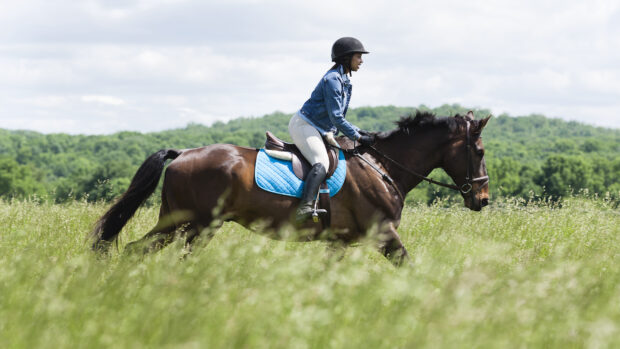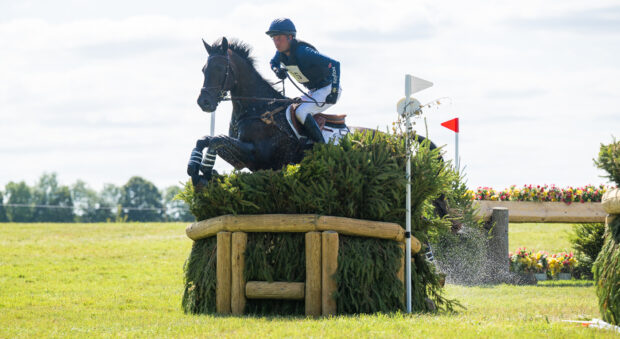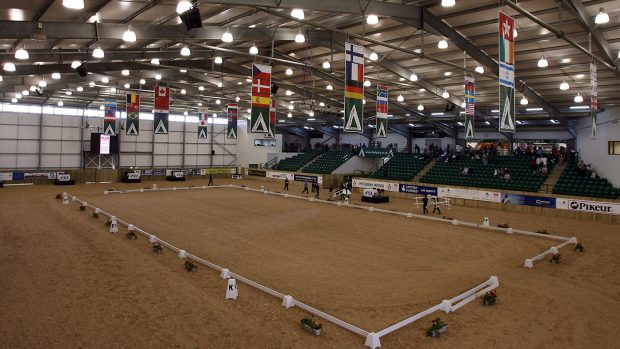Often the horses that come to us are sent for long-term rehabilitation for soft tissue injuries or surgery, but we also get equine athletes who come in for a bit of a tune-up off the back of, or prior to their competition season.
We had a little mare sent a couple of weeks ago for just this reason, and we had a fortnight to work some magic on her.
She was a lovely horse (pictured above) with a great attitude to her work, which really helps when you’re working on such a tight timescale. Our brief was to change her posture in terms of the way she held herself during exercise, which had been compromised by a lack of propulsion from the hind legs.
The owner’s main complaint was that she didn’t really have a canter; ie. despite schooling, the quality of it just wasn’t improving.
Following veterinary assessment prior to her arrival, the mare was diagnosed with right hind limb lameness emanating from the TMT joint in her hock, combined with muscular pain just under the saddle. These issues were addressed by medicating both the hock and the epaxial muscles behind the withers with corticoststeroids, prior to coming on to us.
The mare moved really well, but found it very hard to control her power and carry herself, preferring instead to duck below and behind the contact. One of the results of her difficulty in driving with the hind legs was acute muscular pain and tightness on the underside base of her neck, which she had been using to balance herself while dropping on to the forehand.
Her work programme included a combination of incline treadmill exercise and long reining, and then ridden exercise too as we progressed into the second week of her stay. The owner was quite happy to ride himself which was great as it gave us a good marker of her progression. The key thing in this case was that although we expected her to strengthen up a bit in her two week bootcamp with us, more important was the change in how she handled her power and held herself. Phase two was to come post-discharge where we expected her to become stronger and more consistent in her performance with time and work.
It sounds pretty obvious; the key to her success was a combination of her veterinary treatment and the opportunity for her to operate without the weight of a rider via her treadmill exercise and ground work. Although not everyone has the use of a treadmill to facilitate this kind of training, ground schooling on its own can be a very useful tool to make a rapid improvement in a horse. This is particularly true in cases of back pain where you want to give veterinary treatment time to work without confounding the problem by putting weight on them.
For us, a short-stay rehabilitation can be a really useful tool for cases where the owner/rider wants to put in the work hours themselves but needs a bit of a kick-start to help lay the foundations. From a cost perspective we also often do this kind of work when the horse is not insured. If that is the case it is really important to get the timing right; the horse needs to have had any treatment needed beforehand and be ready to hit the ground running, so that as far as possible we can use every day of the stay to positive effect.
For the horse in question, it was fantastic to see such a change in really quite a short time period, and I think huge credit needs to go to her owner for not letting her issues go too far before they were addressed. Generally speaking, the longer a lameness or pain issue goes unrecognised or untreated, the more difficult a time you will have getting back to where you want to be in the long run.
Operation athlete and a load of dead bugs

Last weekend we welcomed a group of British Dressage members to our Rider Performance Centre for an event organised in association with the BD south west region, spearheaded by the fantastic Mandy Heath.
We’ve worked a lot with Mandy over the years, running different tours and clinics for those under her jurisdiction and so it was quite fitting that our first big event in the new centre should be for her.
The day focused on optimising body control, improving performance and preventing injuries in riders. It was designed to help those taking part understand the strengths and weaknesses of their bodies and the best way to address them, in addition to realising the impact of these issues when riding.
There is relatively little understanding of the rider as an athlete in comparison to other sports such as rugby, football and swimming. As a member of the academic team at Hartpury, Jenni Douglas has produced some of the first bits of research in to the physiological demands placed on riders; during which she looked into the heart rate, respiratory and muscular responses of the body while riding. Research into the rider as an athlete is important because only by fully understanding the forces and demands placed on an individual while riding, can we know how to train properly off the horse for the needs of different disciplines.
The first half of our British Dressage day was handed over to putting all attendees through a standardised screening process. This is when a full spectrum of physical measurements and information on each individual is taken, and for the purposes of the day, highlighting what needed to be worked on. We then moved on to both a postural training workshop in the afternoon and a training session running through basic movement patterns for exercises done either in the gym or at home.
I wanted the feeling of the day to be very comfortable and informal but yet wholly informative and interesting. The group of riders who came were fantastic and really epitomised what I’d hoped for and my enduring memory will be eight riders lying next to each other doing the “dead bug” at the end of the day! For those of you who don’t know what a dead bug is, look it up and you’ll understand why it was quite a cheering sight!
Fizz





